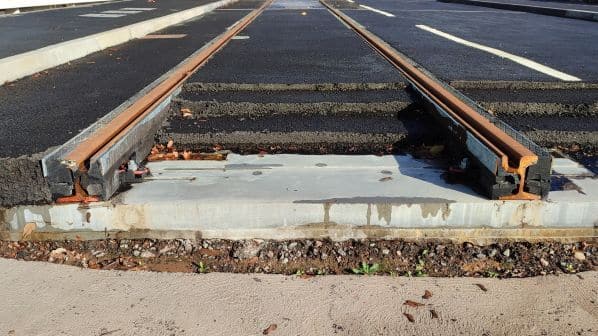IMAGINE a rail-based urban transport system that will be built in a capital city through to a small town for a fraction of the cost of conventional light rail. And that can be installed, removed and repaired quickly, economically and efficiently.
You might not have to imagine much longer thanks to a newly-patented very light rail (VLR) trackform that is currently under development in Britain. Prototype track panels have already been installed in several locations and a real-world demonstration line could be operational next year.
The idea for developing a new trackform originated in the British city of Coventry, 150km north of London, where local authority Coventry City Council was considering plans to create a light rail network. But the cost of a conventional system proved prohibitive and so the idea was discarded.
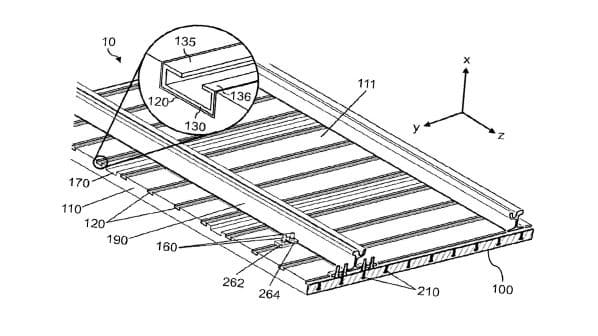
However, an existing partnership with the nearby University of Warwick, and its Warwick Manufacturing Group (WMG), resulted in an unexpected outcome. This university department works to develop and prove engineering prototypes which can be brought to market as production versions by commercial manufacturers. It has an impressive track record in devising new parts and materials, particularly for the automotive sector.
“One of our directors was visiting WMG in 2016 and saw a model of a proposed lightweight tram vehicle,” explains Transport for West Midlands (TfWM) VLR programme director, Ms Nicola Small. “That got him thinking and led him to ask the question whether it would be possible to design an even lighter vehicle that ran on much lighter track.”
WMG was happy to rise to the challenge and began some creative thinking to devise a solution for Coventry’s public transport needs. It soon refined these thoughts into a specific concept of a modular track system that could be laid in a much shallower trench than existing trackforms and so avoid much of the cost of building a conventional light rail line.
Digging up utilities
“We looked at systems around the world, and in particular the West Midlands Metro (WMM) in Birmingham, which is the nearest light rail network to the university,” says Dr Darren Hughes of Warwick University and project lead at WMG.
“It became clear that much of the cost of building a new light rail line in an existing urban area was related to digging up highways to reroute utilities.” Every well-established town or city is likely to have a huge web of pipes carrying gas, electricity, water, sewage and telecoms lines buried not far below street level.
Construction of a conventional light rail line usually involves excavating up to 1m below the road surface, with a minimum depth of around 560mm. The problem is that utilities are often present at precisely these depths, so will either need to be buried more deeply or rerouted away from the alignment altogether.
Proving the concept
THE first installation of the Coventry VLR trackform took place within the grounds of Warwick University, where the first track panels were also displayed, in summer 2022.
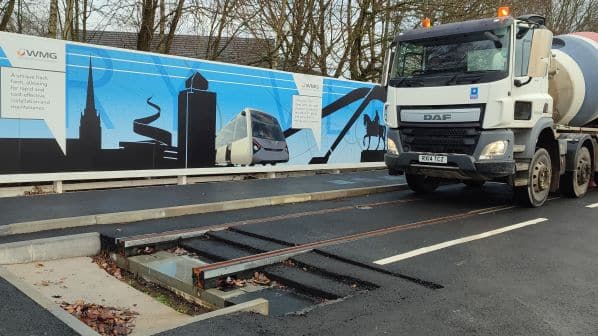
“We needed to build a replica piece of road, including demonstration utilities in the university grounds and Coventry Council installed it,” WMG’s Dr Darren Hughes recalls.
Moving thousands of metres of utilities is not only eye-wateringly expensive, it is also hugely disruptive, as anyone who has tried to navigate a city while a new light rail line is under construction will be well able to testify. In addition to being frustrating for those who live and work in the affected areas, there is an economic impact on the city as a whole as businesses are impeded from trading normally.
“We recognised quite early on that the largest cost savings could be achieved by avoiding buried utilities as much as possible and ideally altogether,” Hughes says. “We started with the premise that the maximum depth of a VLR system could be 400mm. We have to bear in mind that it is not just the excavation depth itself that needs to be taken into account but the loadings of vehicles working on an excavated surface.”
WMG’s early work suggested that a trackform of steel rails running on a concrete base and covered with an asphalt top layer would work well. WMG’s automotive sector experience was particularly helpful as the just-in-time supply chain principles widely used in the industry were adopted for the new VLR design.
“We realised that if we created a modular concrete base, it could be manufactured and stored off-site and then delivered to the installation team as needed” Hughes says. “This is important in inner city areas where storage facilities are often limited.”
Having established the concrete base, thoughts turned to the rails. And in what appears to be a very smart move WMG opted to specify a standard light rail profile, rather than trying to reengineer an existing type of rail or develop one from scratch. “We realised that the issue was complexity around the track, rather than track itself,” explains Dr Chris Micallef, technical consultant at Coventry City Council, who originally started working on the project at WMG. “The advantage of using standard tramway rail is two-fold,” he says.
“Firstly, it is readily available off the shelf and that brings costs down. Secondly, it is compatible with existing conventional light rail networks, so if operators want to run VLR vehicles over a standard network they can easily do so.”
The only downside of this decision was that it limited the space available for the concrete base. “The rail is 158mm high so we knew that we didn’t have a lot of room to play with for the base,” admits Micallef.
At this point, having established a well fleshed-out concept, WMG and Coventry turned to the rail industry to model and produce detailed designs that could then be used to build prototype sections of track. An open tender was issued in 2019 and the contract was secured by French engineering consultancy Ingerop.
Working through the company’s British subsidiary Rendel, engineers established that to withstand the required loadings using conventional rails and with limited depth would require an exceptionally strong concrete base. “The result is a highly-engineered solution using a composite for the base panels,” explains Micallef.
Load trials provide cumulative data
THE second installation of the Coventry VLR trackform was a 70m stretch of straight track at Coventry City Council’s Witley recycling depot in February 2023. A test site was needed to prove that the modelling predictions for loadings were accurate in real-life scenarios. “Our main concern was that the track was able to withstand the regular passage of heavy goods vehicles, rather than any light vehicles running on the tracks themselves,” Coventry City Council’s technical consultant Dr Chris Micallef says. “We originally looked for suitable sites on public roads in and around Coventry, but it became clear that putting even a short stretch of track into a public highway would require substantial regulatory approvals.”
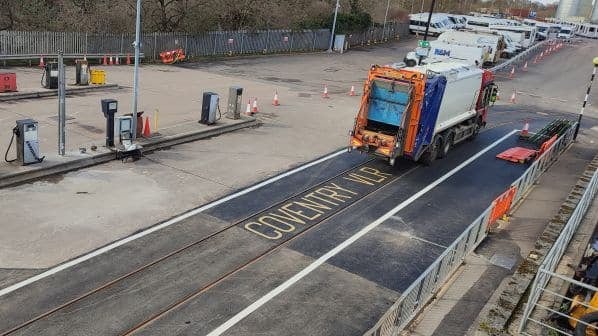
Instead, the council looked to its own facilities and identified the depot at Witley as a potential location. “It turned out to be ideal,” Micallef says. “It is used by hundreds of dustcarts a day as they enter and leave the depot and the lorries often stop where the track is located before moving off again, so we know that the track is being exposed to the heaviest dead loads they are likely to encounter in daily use.”
In what Micallef believes is a world first, the test section has been fitted with over 50 sensors that monitor forces working on both the rails and the track panels. “Unlike one-off load tests these sensors are collecting data continually,” he says. “We are able to build up a picture over time and get a good understanding of what is effectively an accelerated wear and tear test.”
Rather than using a standard mix, high-performance concrete is used to produce a cementitious composite that is reinforced with steel fibres. Also known as ultra-high performance fibre reinforced concrete (UHPFRC), this material provides the strength needed to withstand not just the VLR vehicles running on the track, but the much higher weight and frequency of road vehicles driving across or along the tracks.
Design work was due to start just as the Covid-19 pandemic hit, but Micallef says the team adapted to working remotely remarkably well. During this phase the height of the concrete base was optimised and the team managed to reduce the depth of the trench required for the trackform to just 300mm.
After 18 months the final designs were ready and the first track panels were produced. So far, they have been installed in three locations (see separate panels). A battery-powered VLR demonstrator vehicle was developed separately to work over a short test track at Dudley’s National Innovation Centre.
An important caveat
WHILE the Coventy VLR trackform has a huge number of potential applications worldwide, it isn’t suitable for every location, as WMG project lead, Dr Darren Hughes, is keen to point out.
“The cost savings of our VLR track are greatest in established towns and cities, where there are many existing utilities that need to be avoided. Obviously in towns and cities which are being developed on greenfield land those utilities aren’t there and can be designed around the location’s transport networks.”
Hughes adds: “In these cases, the cost differential between VLR and traditional light rail systems becomes much smaller and it might well be more cost-effective to install conventional networks. There are still savings to be made with the Coventry system as far as removal and repair of installed track is concerned, but overall VLR track is best-suited to the creation of new or the extension of existing networks in well-established towns and cities.”
But the real test for the new trackform will come next year when a fully-fledged demonstration line is due to start operating in Coventry city centre.
This demonstrator line should prove definitively how quickly the VLR trackform can be installed - the model suggests it can be constructed at the rate of 100m per day, considerably more than for conventional light rail projects. But Micaleff concedes that the model is based on a closed off road. “In the real world we won’t be able to close whole sections of road for long periods,” he says. “Even so, we expect the time savings to be substantial.”
The modular design should also save time and cost when panels need to be repaired, as replacements can be quickly slotted in, while the original panels are taken away for attention.
The real clincher is whether the cost savings that were central to the whole concept can be achieved.
Conventional light rail lines can cost between £25m and £100m per km. “We reckon that the average cost is £40m per km, so we set out to reduce that by 75%,” Micallef says. “Because of inflation we don’t know whether it’s still possible to hit our target of £10m per km for Coventry VLR at 2019 prices, but we’re hopeful.”
Creative thinking
Crucial to the success of the Coventry VLR track project has been a willingness to think and act creatively. “When it came to the design tender, innovation rather than cost was key,” Micallef says. “The ability to be open to new ideas is so important and we need to be continually careful that we don’t incorporate old ways of thinking.”
Fresh thinking will still be required for elements of the Coventry VLR track, such as points and crossovers. Only plain track has so far been installed and designs for more complex trackwork have still to be finalised. Whether these heavier pieces of engineering can fit within the 300mm depth available for plain track remains to be seen, although Micallef points out that this might not be necessary. “It would be unadvisable to lay points over utilities, as when access to the utilities is required it would result in the points being out of use for some time,” he says.
Dudley test centre could attract worldwide interest
THE third and most extensive installation of the Coventry VLR trackform to date took place in October 2023 at the Black Country Innovative Manufacturing Organisation’s (BCIMO) newly-built National Innovation Centre (NIC) in Dudley, a town approximately 60km from Coventry and also located in the West Midlands region.
Here on the site of a disused railway station and trackbed, BCMIO has built a 2.2km test track for those designing new rail vehicles and rail-based applications. Most of the test track is conventional heavy rail, but the final 60m, next to the NIC, has been laid with Coventry VLR track.
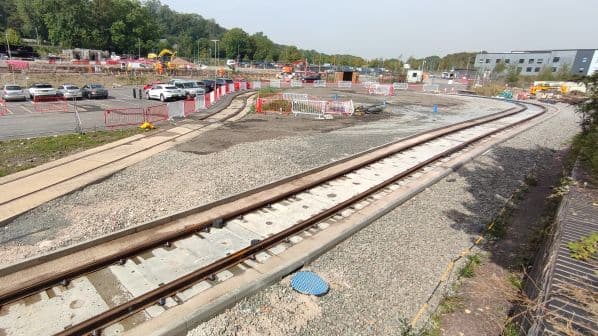
The section includes both a gradient and 15m radius curves on a balloon loop that was designed to prove that VLR vehicles could successfully negotiate curves that would be impossible for conventional LRVs.
“We’re delighted with the way the Coventry VLR project has turned out,” says BCIMO CEO, Mr Neil Fulton. “Our site is a proving ground for all types of trains and track and the VLR project is doing exactly that.”
As well as the test track, the NIC includes both engineering and office space for hire to rail-related project teams.
“Most of that space is now fully let,” Fulton says. “But we expect there to be regular movement of people as projects start and end. Most of the companies coming here at the moment are British-based, but the combination of the NIC and the test track is pretty unique, so we expect to have more interest from companies outside Britain.”“It might be useful from a uniformity perspective to have the whole track system made to the same design, but I’m not convinced,” he adds.
Overall, the prize for maintaining an open mind is a new trackform, patents for which were recently granted to Coventry City Council. The technology has the potential to be adopted in cities across the globe, or as Hughes neatly summarises it: “this is a game-changer when it comes to installing rails in complex urban centres.”
